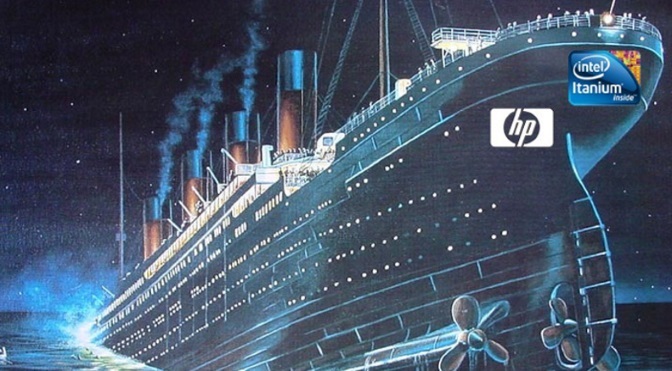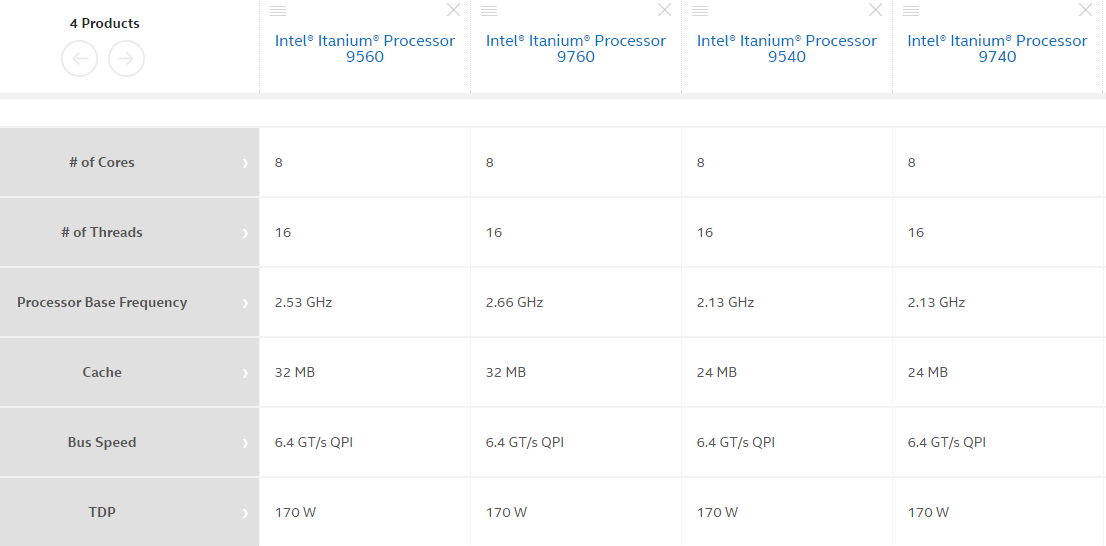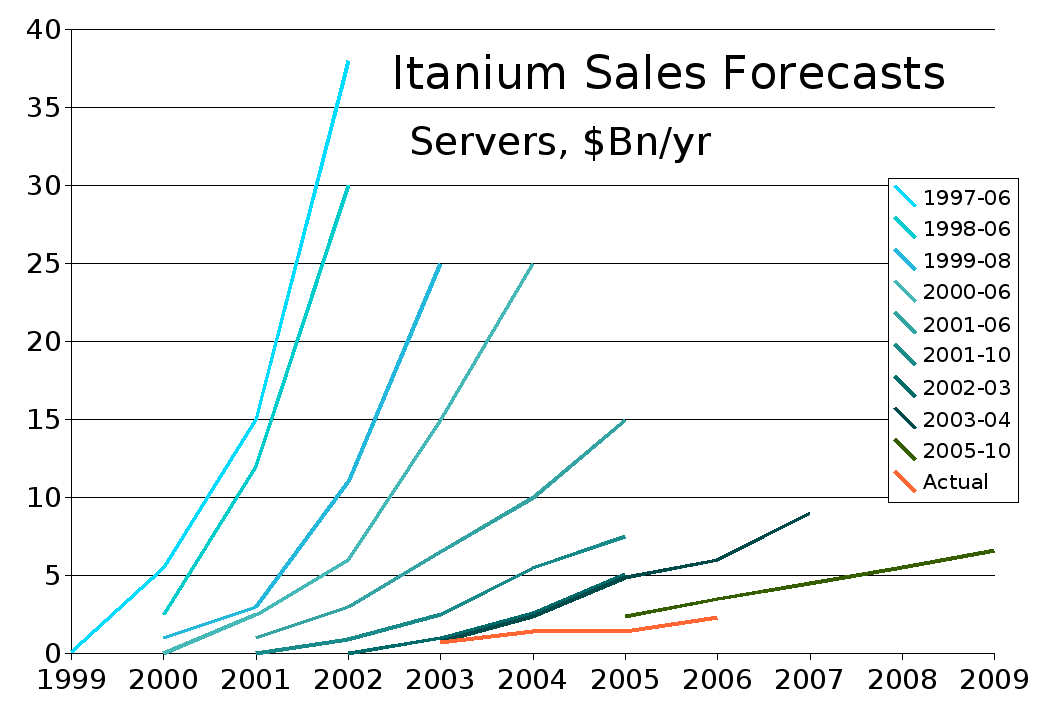Intel Itanium processor officially died

The Intel Itanium processor is an IA-64 microprocessor (EPIC) microprocessor, developed jointly by Intel and Hewlett-Packard and introduced May 29, 2001, that is, almost 16 years ago. Due to unsuccessful marketing and low sales, this processor with huge ambitions was ironically called Itanic, in tune with the famous transatlantic liner.
At one time, IA-64 architecture was called revolutionary. It should have replaced x86 on 64-bit servers and desktops. But something went wrong. Years of development and promotion cost billions of dollars to Intel and Hewlett-Packard, but now their torment has come to an end. On Thursday, May 11, 2017, Intel began shipping the Itanium 9700 chip (codename Kittson) - this is officially and definitively the latest chip from the Itanium family, representatives of Intel confirmed .
Intel support has declined in the last decade, so that these processors gradually left the stage. Server manufacturers have stopped the release of new models on Itanium, the software update also stopped, and Intel itself openly recommended to customers
switch to xeon xeon processors, so the final farewell to the Itanium lineup was not surprising. Well, Intel can now fully focus on the Xeon - a successful family that is booming.
')
The Itanium 9700 model, made on 32 nm process technology, is a small update of the previous model with the code name Poulson, which was intended for high-performance Unix servers and was released in 2012. As the table shows, the difference between Poulson and Kittson is really small.

The only major buyer of these processors is the company Hewlett Packard Enterprise, which will upgrade its servers Integrity i6. These servers run under the HP-UX operating system. The Itanium 9700 is plug-in compatible with Poulson, so it's easy to upgrade. Integrity i6 servers with new processors are priced from $ 14,500.
In the 90s, the Itanium processor was developed by Intel together with Hewlett-Packard. The latter was looking for a way to upgrade its aging PA-RISC architecture and adapt it for modern 64-bit server chips, on which traditional old OSes like Unix can be run. At that time, Intel was just looking for a way to enter the high-performance server market - and the partners found each other. Together, they offered an alternative in this market to existing mainframe architectures like Oracle / Sun SPARC and IBM Power. At first, it seemed like an innovative technology that could succeed.
HP and Intel engineers suggested that the EPIC (Explicitly Parallel Instruction Computing) microprocessor architecture (“computation with explicit machine instruction parallelism”) based on the VLIW can overcome the inherent limitations of RISC and help increase processor performance without increasing clock speeds by executing more and more instructions per cycle, with the instruction scheduler, branch prediction, etc., removed from the processor and transferred to the compiler. In theory, this was supposed to free up space on the chip for additional execution modules and increase parallel performance. But in practice it did not work. Truly effective compilers have not been created. In addition, EPIC is so radically different from other architectures that ARM and x86 can be considered twin brothers in comparison with it.
Before the release in 2001, the IA-64 architecture was presented as revolutionary. The illustration shows which predictions for Itanium sales were made in different years, and the real sales after the fact are shown in orange.

The first processors of the Itanium family turned out to be incredibly voracious in terms of power supply. They needed powerful cooling. Processors were expensive and difficult to manufacture. And they entered the market many years later than planned.
Intel originally wanted to release a consumer version of the IA-64 for desktops, but this never happened, and the market quickly changed when AMD launched the first 64-bit processors on the x86 architecture in 2003 (Opteron on the AMD K8 architecture with the AMD64 instruction set ), while Intel had only 32-bit back then. Intel had to catch up with its 64-bit version of x86 (Intel even implemented a set of instructions from AMD, which is now known as x86-64), and the development of Itanium then faded into the background. Instead, on the contrary, 64-bit processors on the x86 architecture began to conquer the market of high-performance servers.
The most powerful blow to the gut Itanium received in 2010 from Microsoft. She then announced that Windows Server 2008 R2 will be the latest server operating system with Itanium support . In March 2011, Oracle also announced the termination of any software development for Itanium . And in the statement, Oracle had a direct claim to the management of Intel, which "made it clear that their strategic goal is the x86 microprocessor, and that Itanium is at the end of its life cycle." After that, HP sued Oracle, demanding continued support for Oracle software for users of its HP-UX servers.
In the end, Xeon processors even caught up with Itanium in terms of functionality. So, in the 15-core Xeon E7 v2 (2012), Intel implemented some of the unique features of Itanium. By then, HP had made it easier for customers to migrate from Itanium servers to Xeon x86 servers. It became clear that the collapse of the production of Itanium is not far off. But it was not so easy, because many customers who purchased this equipment required support and did not want to give up Itanium. So HP continued to release servers, and the Itanium processor family lived a little longer than planned.
HPE says Itanium server support will continue until 2025, and the latest HP-UX 11i v3 2017 update will be released in June.
Summing up, Itanium was one of the interesting experiments with microprocessor architecture, and it lasted much longer than others succeeded. Many say that the x86 architecture is outdated. And Intel itself has repeatedly tried to replace it. Itanium is another such attempt, but x86 is still on horseback.
Source: https://habr.com/ru/post/373453/
All Articles